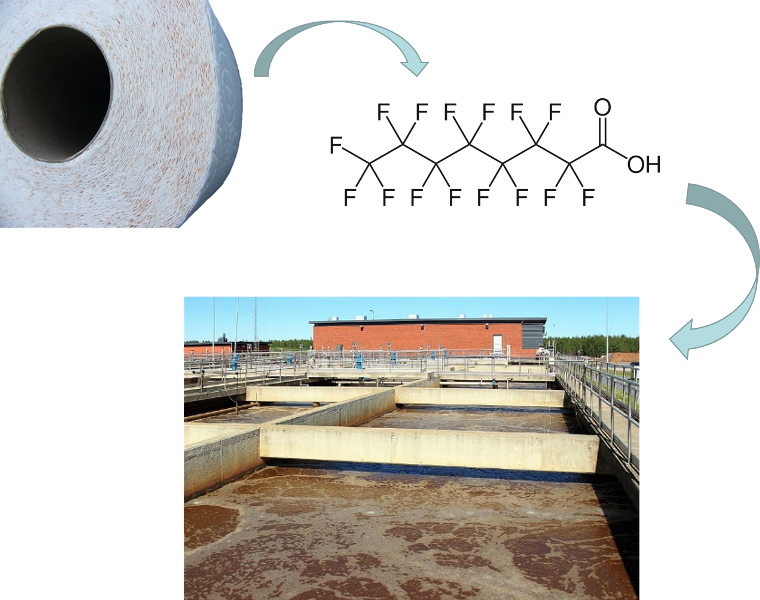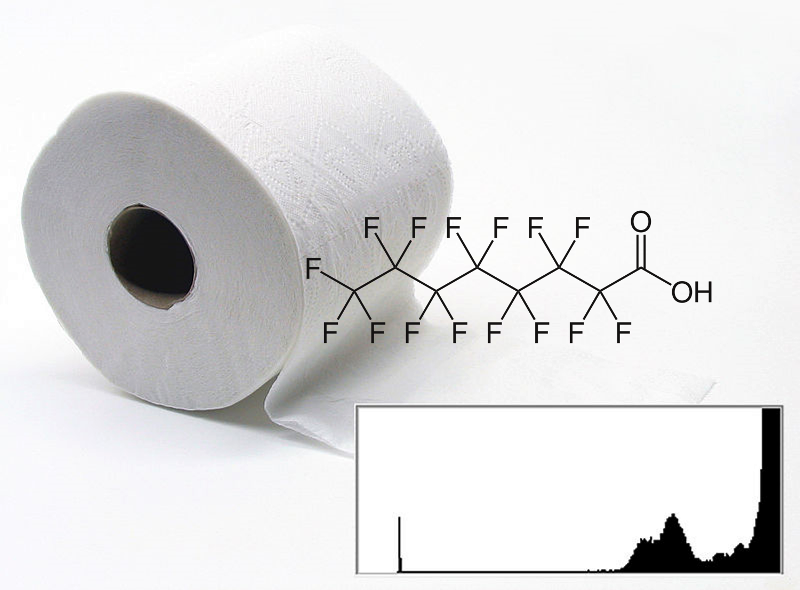Toilet paper contaminates wastewater with PFAS
Perfluoroalkyl and polyfluoroalkyl substances (called PFAS) belong to a diverse group of man-made chemicals that have found a wide variety of uses in industrial and consumer products. Thanks to their resistance to grease, water and heat, they have been used to make stain- and fire-resistant fabrics and carpets, cleaning products, cosmetics, paints, insecticides, fire-fighting foams, food packaging and non-stick utensils, among others. But these same properties make PFAS substances that do not break down easily, causing them to bioaccumulate in the environment and our bodies, and have been found to be associated with serious health conditions. And these substances tend to find their way into wastewater after domestic use, and although there are several known sources of origin, a new one has now been detected, toilet paper.

Toilet paper is a possible source of PFAS entering the wastewater system. Source: image elaborated in Powerpoint, the image of the toilet paper and the wastewater treatment plant are in the public domain.
When looking at the composition of wastewater, one can get an idea of the different substances that are being discharged into domestic effluents, revealing the incorporation of substances harmful to health in household work or whether a community has been exposed to a particular chemical. And recent research has pointed to toilet paper as a potential source of PFASs.
What are PFAS?
Perfluoroalkylated and polyfluoroalkylated substances (PFAS) are synthetic (not naturally occurring) organofluorinated chemicals consisting of an alkyl chain of varying length, usually from 2 to 16 carbon atoms, that has at least one carbon atom of a fully or partially fluorinated methyl or methylene group. In perfluoroalkyl compounds the fluorine atoms have replaced all the hydrogen atoms attached to the carbon of the chain, whereas in polyfluoroalkyl compounds there are fluorine and hydrogen atoms attached to the carbons of the main chain.

Example of Per- and polyfluoroalkyl substances. Source: image elaborated in Powerpoint.
Thousands of these substances have been catalogued, being an important group of them the so-called fluorosurfactants, which have a hydrophobic fluorinated alkyl chain and a hydrophilic group at the end of the chain, being considered surfactants, which are very effective in reducing the surface tension of water, Within this subgroup stand out perfluorosulfonic acids, such as perfluorooctanesulfonic acid (PFOS), which are widely used in the manufacture of paints, inks, adhesives and any application where surface tension determines the performance of the product.

Skeletal structure of PFOS. Source: Wikipedia.org.
Although in the early days of the use of these substances they were considered inert, their chemical stability has shown that over time they tend to bioaccumulate, reaching levels where damage to health becomes evident.
PFAS in toilet paper
Although PFAS substances have been used to manufacture different types of consumer products, such as cosmetics and toiletries, which after use are flushed down the drain, this is one of the main sources of contamination of wastewater by this type of substance. But, although it had not been considered that toilet paper could be a potential source of PFAS, some researchers had assumed it, since in many countries it is common for toilet paper to be thrown down the drain and some manufacturers add these substances during the separation of cellulose from wood to manufacture the pulp with which the paper is made, so it is likely that the final product is contaminated with these substances.
A group of scientists set out to determine whether toilet paper was a possible source of PFASs entering the wastewater system by analyzing samples of toilet paper and wastewater for these compounds.
To do so, the researchers collected toilet paper samples from North, South and Central America, Africa, and Western Europe, and collected sludge samples from wastewater treatment plants in the United States; these samples were then analyzed using an ultra-high pressure liquid chromatography-mass spectrometry detector-mass spectrometry (UHPLC-MS/MS) system.

PFAS substances are detected in toilet paper. Source: edited image, original from Wikipedia.org.
According to the results of the study, the main PFAS compounds found in the samples are disubstituted polyfluoroalkylphosphates, especially 6:2 fluorotelomer phosphate diester (diPAP), a fluorotelomer-based polyfluoroalkyl substance that has the potential to transform into perfluorooctanoic acid, a more stable and potentially carcinogenic compound.
According to the study, 6:2 diPAP was the most abundant PFAS substance found, although it was in parts-per-billion ranges, and it was able to estimate that toilet paper use contributed from 6. 4 to 80 μg/person-year of 6:2 diPAP in wastewater, so they conclude that toilet paper should be considered as a potential pathway for PFASs to enter wastewater, and although in the United States PFASs entering wastewater come from mainly cosmetics, textiles, packaging or other sources; elsewhere toilet paper represents a major source.
Toilet paper is certainly an unusual source of organofluorinated substances, but it is important to be aware of all the sources that can contaminate waters with organofluorinated substances.
Well friends, I hope you liked the information, see you next time!
References
Wikipedia.org. Per- and polyfluoroalkyl substances.
Jake T. Thompson, Boting Chen, John A. Bowden, and Timothy G. Townsend. Per- and Polyfluoroalkyl Substances in Toilet Paper and the Impact on Wastewater Systems. Environmental Science & Technology Letters. March, 2023.
Agencia Española de Consumo, Seguridad Alimentaria y Nutrición. Preguntas y respuestas sobre los PFAS.